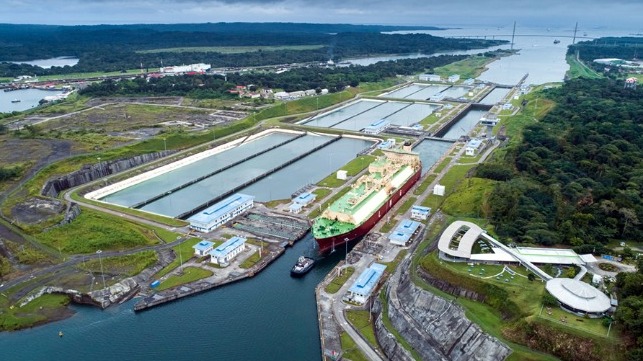Panama Canal Marks Milestone Transit as it Works to Manage Operations

The Panama Canal recently marked a significant milestone with the 10,000 transit of a Neopanamax vessel through the expanded canal. The newer, enlarged locks for the canal opened just over four years ago.
The milestone transit was completed by one of the large LNG carriers that regularly transit the Panama Canal since the opening of the Neopanamax locks. Sailing from the United States to China, the SK Resolute, with a capacity of 180,000 m3 of liquefied natural gas, made the transit on August 10 as part of her regular service. According to the Panama Canal Authority, the significant reductions in voyage time provided to LNG carriers by the new locks helped to create a highly competitive route for U.S. gas deliveries to major Asian importers.
The development of the Neopanamax Locks was seen as a key step as ships grew to maintain the Panama Canal’s role in shipping. Today, the Neopanamax Locks handled 27 percent of transits and half of total tonnage at the canal. The LNG segment represents 12 percent of transits at the expanded canal according to the Panama Canal Authority, surpassed only by container ships with 46 percent and liquefied petroleum gas (LPG) with 25 percent.
"Reaching this mark just over four years after the opening of the expanded canal, reaffirms the competitiveness of the interoceanic highway, backed by the continuous, safe and reliable service that we have maintained in the midst of the current world situation," said the administrator of the Panama Canal, Ricaurte Vásquez Morales.
The impact of the pandemic on global trade as well as the trade wars and the suspension of the cruise industry, however, has taken a toll on the Panama Canal’s operations. In May, for example, they reported a 21 percent drop in the number of ships making the transit compare to their budget. A total of 937 ships transited the canal while an additional 260 transits were canceled according to Vásquez. Nearly half of the cancelations came from LNG and LPG tankers while the canal also reported the loss of the cruise ship traffic that is usually at a peak in the spring as lines repositioned from the Caribbean for the summer months in Alaska.
Recently, the Panama Canal Authority announced that it was increasing by one foot (0.3 meters) to 48 feet (14.63 meters) the maximum authorized draft for the transit of the Neopanamax Locks. The authority is seeking to permit transits by as many large vessels as possible, but it noted that the draft is dependent on water levels in Gatun Lake. Ships may be required to off-load cargo or take other measures to decrease their draft to transit the locks depending on water levels.
Canal operations also continue to be challenged by declining rainfall amounts, critical to replenish the reservoirs that fuel the operations. In six of the first seven months of 2020, the region experienced below-average rainfall amounts. As a result, the Panama Canal Authority recently reported that as of the end of July, the Gatun reservoir, which supplies the operation of the interoceanic highway, was at a level just under 26 meters, below the guide curve and 0.28 meters below the minimum desirable level for this time of year. The canal authority is continuing studies that it expects to complete in 2021 aimed at strengthening the efforts to manage the water resources of the Panama Canal.
